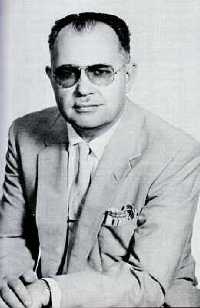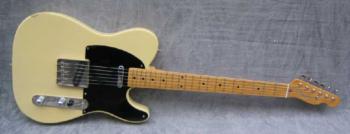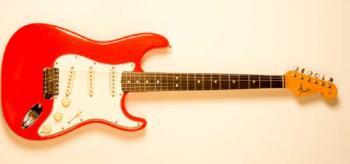 SKC Films Library SKC Films Library |
| SKC Films Library >> Musics >> Biography: Other |
| Leo Fender designer and builder of solid-body electric guitars
Clarence Leonidas Fender was born to Clarence Monte Fender and Harriet Elvira Wood, owners of a successful orange grove located between Anaheim and Fullerton, California, on August 10, 1909. Interested in electronics from an early age, Fender began repairing radios in a small shop at the family farm when he was about 14. After graduating from Fullerton Union High School in 1928, he entered Fullerton Junior College, where he majored in accounting. He continued to teach himself electronics, but never took formal courses in the subject. After college, Fender took a job as a deliveryman for Consolidated Ice and Cold Storage Company in Anaheim, where he later became the bookkeeper. He subsequently became an accountant for the California Highway Department in San Luis Obispo, but his job was eliminated as a result of the Great Depression. He then took a job in the accounting department of a tire company, but that job also fell to the Depression-era economy. In 1938, Fender decided to forego accounting and take up electronics as a profession. Borrowing $600, he started Fender Radio Service in Fullerton, and before long he was building, selling, and renting PA systems he designed himself, as well as amplification equipment for acoustic guitars and for the electric "Hawaiian lap" guitars (aka steel guitars) that were becoming popular in country music. In the early 1940's, Fender met Clayton Orr "Doc" Kauffman, the inventor of the "Vibrola Tailpiece," precursor to today's "whammy bar." The two subsequently formed the K & F Manufacturing Corporation to design and build amplified Hawaiian lap guitars and amplifiers. In 1944 they jointly patented a lap steel guitar that incorporated an electric pickup previously patented by Fender, and they began selling the guitar as a kit, complete with Fender-designed amplifier, the following year. The two men had different visions of the company's future, however, and they parted ways in 1946. Changing the name of the company to the Fender Electrical Instrument Company, Fender continued to sell the lap steel guitar he and Kauffman had patented. He also designed and began manufacturing a series of amplifiers, including the Deluxe, the Professional, the Dual Professional, and the Princeston. In 1948, he introduced the Champion series, which quickly became one of the most popular practice amps ever built. early 1950's Fender Champion amplifier As more and more musicians began using amplified acoustic guitars, Fender saw the potential for a self-amplified, solid-body guitar, and in the spring of 1950 he introduced the Fender Esquire. The body of the Esquire was one solid piece of ash wood, and the neck was one solid piece of maple wood, without a truss rod inserted, which was bolted onto the body. It had a single pickup, a tone selector switch, a volume knob, and one tone knob, and the tuning heads were located all on one side of the neck. A two-pickup model was introduced in June of 1950, and a neck truss rod was added in November, at which time it was renamed the Broadcaster. In 1951, after learning that the Gretch Musical Instrument company already had a line of drums called Broadkaster, Fender changed the name of his guitar to Telecaster, taking his cue from the new and increasingly popular medium of television. An instant hit with country musicians of the day, the Telecaster is still being produced to this day. In late 1951, Fender introduced the Precision Bass, a single-pickup solid bodied bass guitar with a 34" scale. With a fretted neck, and a double-cutaway body, the bassist was able to play "with precision," hence the name. In early 1952, Fender introduced The Bassman amplifier, a 35-watt amplifier designed for the Precision Bass. Fender's most iconic guitar, the Stratocaster, was introduced in 1954. With three pickups instead of two, a modern shaped, contoured body, reminiscent of the "wings" that were beginning to appear on cars, a vibrato tailpiece that allowed the guitarist to "bend" notes, and a name that made one think of outer space, the "Strat" was an instant hit, and eventually became the single most popular electric guitar. The list of musicians who have earned acclaim while playing Stratocasters includes Randy Bachman, Jeff Beck, Eric Clapton, David Gilmour, George Harrison, Jimi Hendrix, Buddy Holly, John Lennon, Pete Townshend, Ike Turner, Ritchie Valens, and Stevie Ray Vaughan. By 1965 Fender's workaholic lifestyle was taking a toll on his health and he sold his company to CBS for $13 million; he then joined CBS as a consultant and guitar designer. In 1971, Fender, Forrest White, and Tom Walker formed Tri-Sonics, Inc., which sold amps and guitars carefully designed so as to not be confused with CBS Fender instruments. Tri-Sonics eventually became Musictek, Inc., and then Musicman, Inc. Fender was elected president of the company in 1975. Musicman was sold to Ernie and Sterling Ball in 1985, after which Fender and George Fullerton formed G&L Guitars. Leo Fender continued to refine his guitars and amps until his death, despite suffering several minor strokes and from Parkinson's Disease, and died in Fullerton, California, on March 21, 1991. Ironically, Fender never learned how to play the guitars that made him famous. SOURCE |
| SKC Films Library >> Musics >> Biography: Other This page was last updated on 06/11/2017. |



